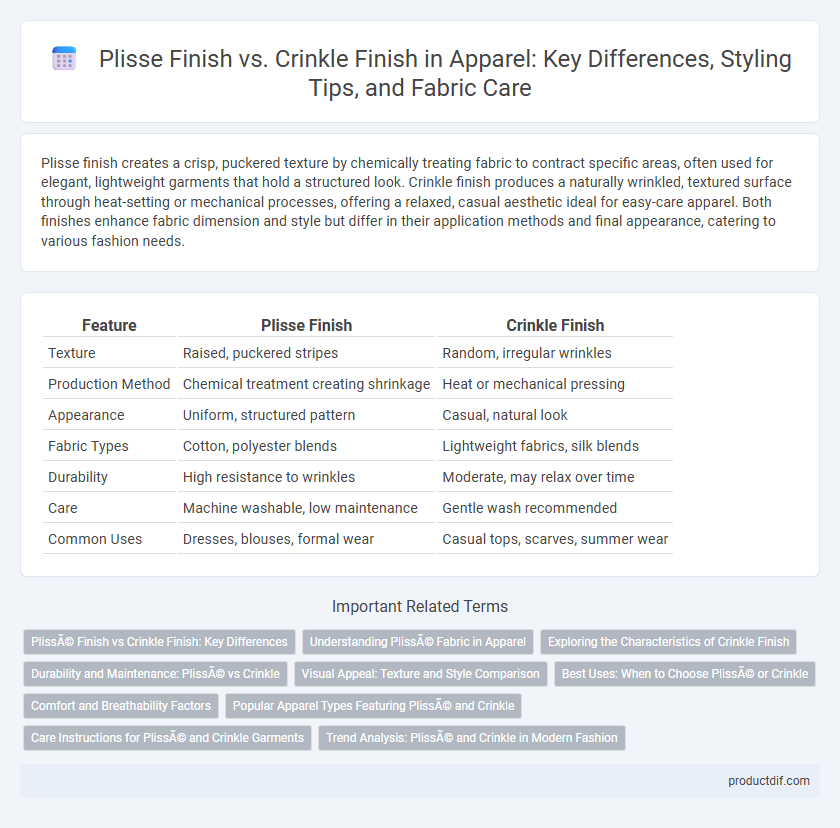Plisse finish creates a crisp, puckered texture by chemically treating fabric to contract specific areas, often used for elegant, lightweight garments that hold a structured look. Crinkle finish produces a naturally wrinkled, textured surface through heat-setting or mechanical processes, offering a relaxed, casual aesthetic ideal for easy-care apparel. Both finishes enhance fabric dimension and style but differ in their application methods and final appearance, catering to various fashion needs.
Table of Comparison
| Feature | Plisse Finish | Crinkle Finish |
|---|---|---|
| Texture | Raised, puckered stripes | Random, irregular wrinkles |
| Production Method | Chemical treatment creating shrinkage | Heat or mechanical pressing |
| Appearance | Uniform, structured pattern | Casual, natural look |
| Fabric Types | Cotton, polyester blends | Lightweight fabrics, silk blends |
| Durability | High resistance to wrinkles | Moderate, may relax over time |
| Care | Machine washable, low maintenance | Gentle wash recommended |
| Common Uses | Dresses, blouses, formal wear | Casual tops, scarves, summer wear |
Plissé Finish vs Crinkle Finish: Key Differences
Plisse finish features a fabric treatment that creates a puckered effect through chemical or heat processes, resulting in a stiff, textured surface that adds dimensionality and structure to apparel. Crinkle finish, on the other hand, relies on a wrinkled, intentionally creased look achieved through mechanical manipulation or fabric composition, offering a softer, more relaxed aesthetic with natural elasticity. The key differences lie in plisse's sharper, more defined texture and rigidity compared to crinkle's irregular, softer wrinkles that enhance fabric flexibility and casual appeal.
Understanding Plissé Fabric in Apparel
Plisse fabric features a puckered, textured surface created through a chemical treatment that shrinks parts of the fabric, offering a lightweight, breathable quality ideal for summer apparel. This finish provides a more structured, durable texture compared to the irregular, softer creases of crinkle finish fabrics, making plisse especially suited for casual shirts, dresses, and skirts. Understanding the unique construction of plisse fabric helps designers select materials that enhance garment aesthetics and comfort with minimal maintenance.
Exploring the Characteristics of Crinkle Finish
Crinkle finish fabric features a textured surface created through permanent pleating or heat-setting techniques, offering enhanced wrinkle resistance and a distinctive, casual aesthetic. This finish is often used in lightweight apparel such as summer dresses, blouses, and scarves to provide comfort and easy maintenance. The fabric's natural stretch and breathability make it ideal for dynamic movements and stylish everyday wear.
Durability and Maintenance: Plissé vs Crinkle
Plisse finish fabric offers higher durability due to its heat-set texture that maintains shape and resists wear over time, making it ideal for long-lasting apparel. Crinkle finish fabric tends to have a less stable structure, often requiring delicate handling and frequent maintenance to preserve its characteristic wrinkled look. Maintenance for plisse is simpler with infrequent ironing needed, whereas crinkle finish demands careful washing and drying techniques to avoid losing texture integrity.
Visual Appeal: Texture and Style Comparison
Plisse finish features a puckered, raised texture created through chemical treatments, offering a crisp, structured look that adds depth and dimension to apparel. Crinkle finish presents irregular, wrinkled patterns formed by heat-setting or mechanical processes, delivering a casual, relaxed style with dynamic surface variations. Both finishes enhance fabric's visual appeal but cater to different fashion aesthetics, with plisse emphasizing refined elegance and crinkle highlighting effortless, textured charm.
Best Uses: When to Choose Plissé or Crinkle
Plisse finish is best suited for lightweight summer apparel and casual wear where a textured, puckered effect adds visual interest and breathability. Crinkle finish is ideal for creating a vintage or bohemian look in dresses and blouses, offering durability with a slightly wrinkled appearance that maintains its texture after washing. Choose plisse for softness and fresh, airy garments, while crinkle excels in rugged, easy-care styles that hold shape over time.
Comfort and Breathability Factors
Plisse finish in apparel offers enhanced breathability and comfort by creating raised, textured patterns that allow air circulation and reduce fabric cling. Crinkle finish, while stylish with its intentional wrinkles, may sometimes limit airflow due to denser fabric folds, potentially reducing overall comfort in warm conditions. Choosing plisse finish garments is ideal for those prioritizing lightweight, breathable wear suitable for hot and humid environments.
Popular Apparel Types Featuring Plissé and Crinkle
Plisse finish, characterized by its puckered texture, is popular in women's blouses, dresses, and skirts, offering a lightweight and breathable fabric option with a distinctive gathered appearance. Crinkle finish, known for its wrinkled, textured surface, is commonly used in casual wear such as tunics, scarves, and summer dresses, providing easy-care, wrinkle-resistant properties. Both finishes enhance fabric aesthetics and comfort, making them favored choices in contemporary apparel design.
Care Instructions for Plissé and Crinkle Garments
Plisse finish garments require gentle washing in cold water and should be air-dried to preserve their textured folds, avoiding ironing to maintain the pleated effect. Crinkle finish fabrics benefit from similar care with hand washing or delicate machine cycles and line drying to prevent the crinkle texture from flattening. Both finishes demand minimal handling and no tumble drying for long-lasting fabric integrity and appearance.
Trend Analysis: Plissé and Crinkle in Modern Fashion
Plisse finish and crinkle finish have surged in popularity within modern fashion, driven by consumer demand for textured fabrics that add depth and visual interest to apparel. Plisse offers a more uniform, puckered texture achieved through chemical treatments, lending garments a sophisticated, lightweight appeal favored in summer collections. Crinkle finish, characterized by irregular, spontaneous wrinkles, conveys a relaxed, effortless vibe suitable for casual and bohemian styles, making both finishes key players in contemporary trend analysis.
Plissé Finish vs Crinkle Finish Infographic

 productdif.com
productdif.com